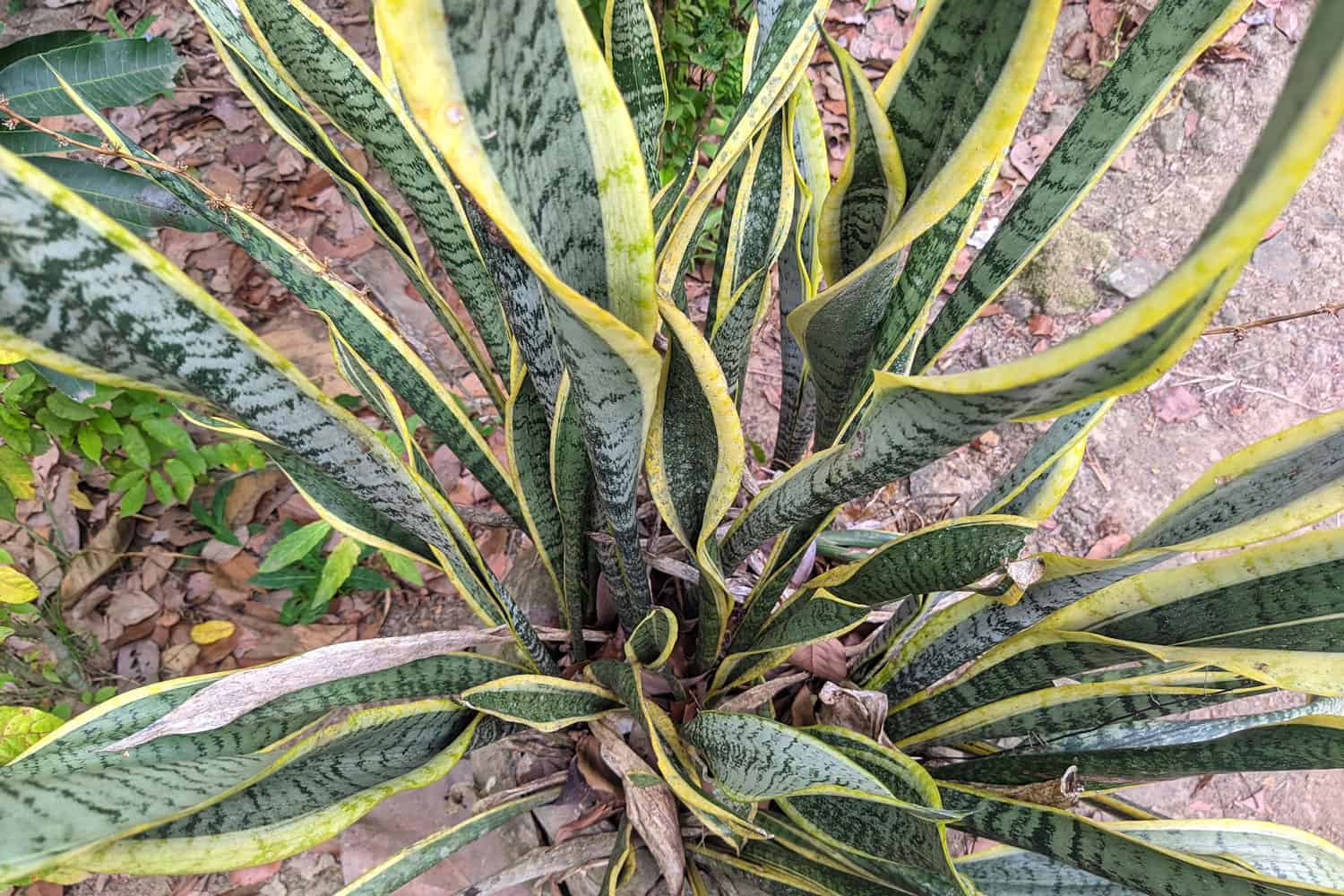Have you ever wondered about the origins of snake plants and the source of their resilience?
In this article we'll discuss the background and native habitat of snake plants, shedding light on how they've withstood the test of time across different cultures and locales.
You'll likely find the history and evolution of these sturdy plants intriguing, along with their roles in traditional medicine and cultural beliefs.
Read on and uncover valuable insights on how they've come to symbolize strength, endurance, and adaptability.

Origins of Snake Plants
Snake plants, also known as Sansevieria, are native to West Africa, particularly countries like Nigeria and Congo.

They grow predominantly in arid and semi-arid environments, making them well-suited for indoor growth due to their low water requirement.
Over time, they have become popular houseplants due to their elegance, ease of care, and air-purifying qualities.
How Did Snake Plants Get Their Name?
The name "snake plant" is primarily derived from the appearance of the leaves, which are long, slender, and resemble the shape of a snake.
The leaves often display a striking pattern with bands of different shades of green, similar to the scales on a snake's skin.
Additionally, the way the leaves grow vertically upwards from the soil is reminiscent of a snake rising from the ground.
In addition to the physical resemblance, snake plants have a rich history in folklore and mythology.
In some cultures, they are believed to bring good luck and protection from evil spirits depending on their placement.
Learn more about snake plant placement here: Unexpected Places Where Snake Plants Thrive in Your Home
This has further contributed to their popularity as houseplants, enhancing their appeal to individuals seeking not only an attractive and low-maintenance plant but also one with symbolic meaning.
Key Characteristics That Helped Them Survive Over Time
Snake plants have an interesting evolutionary history. Their background and native habitat can give you a better understanding of how they've adapted over time.
These plants have adapted to thrive in various environments, such as dry savannas and tropical rainforests. They are very resilient and they have key characteristics to thank for it.
Can Tolerate Low-light Conditions
A key aspect of the snake plant's evolution is its ability to survive in low light conditions. This survival trait has earned them a reputation as excellent indoor plants.
In their natural habitat, they're often found under the shade of taller plants that dominate the ecological niche. This is one of the reasons why snake plants can tolerate low-light conditions so well.
Drought-tolerant
Moreover, snake plants have developed a fascinating way to conserve water.
They have a unique way of processing sunlight through a process called Crassulacean Acid Metabolism (CAM). This allows the snake plant to open its stomata at night to minimize water loss during the day.
This adaptation has made them exceptionally drought-tolerant and well-suited to indoor environments.
Leaf Shape
Lastly, their leaf shape and structure also play a vital role in their evolutive history.
The leaves of a snake plant are long, narrow, and vertically arranged. This structure not only allows them to maximize sunlight absorption but also to effectively store water.
By doing so, they can endure long periods without water, thereby increasing their chances of survival in harsh conditions.
Native Habitats
Here are some places where snake plants can be found.
Snake Plants in the African Regions
In the African regions, you can find snake plants in various native habitats such as West African tropical forests and savannas. These resilient plants thrive in tropical climate with well-draining soils.
A few noteworthy features of African native habitats for snake plants include:
1. Rainfall
Occasional rainfall is beneficial for these plants, as they prefer infrequent waterings.
2. Temperature Range
Snake plants do well in a range of temperatures from 70°F to 90°F (21°C to 32°C).
3. Soil Type
Sandy and well-draining soils are ideal for the growth of these plants.
Snake Plants in the Asian Regions
Asian regions also provide suitable native habitats for snake plants. They can be found in parts of India and Indonesia, where the tropical and subtropical climate favors their growth.
When it comes to the Asian regions, specific habitat characteristics suitable for snake plants are as follows:
1. Light
Snake Plants can tolerate a variety of light conditions, from low light areas to indirect sunlight, making them a suitable choice for different environments within Asia.
2. Humidity
The plants prefer moderate humidity levels, which are commonly found across Asian tropical regions.
3. Growing Conditions
Snake Plants grow well both indoors and outdoors, making them adaptable to different urban and rural habitats.
Snake Plants in Cultures
The snake plant is a fascinating species with a rich background and native habitat.
In various cultures, this plant has been utilized for its unique features and potential medicinal properties.
Macro-Mayans from Mexico
In Macro-Mayan ethnic groups from Mexico, the snake plant has played a significant role in traditional medicine.
According to a study, they have been used for treating ailments and have a strong connection with the culture's history.
Your curiosity might be piqued by the variety of uses and relevance in healing practices amongst these indigenous people.
Hmong people of Thailand
The Hmong people of Thailand also incorporate the snake plant into their lives.
As found in an article, they believe that this plant can protect them from snakes and evil spirits, while also serving as a treatment for snake bites.
The symbolic and medicinal significance of the plant in Hmong culture demonstrates its versatile applications across various ethnic groups.
In Kenya, the medicinal usage of snake plants is also quite prominent.
One research highlights how the snake plant and other local flora are used as antivenom treatments.
The cultural knowledge passed down through generations contributes to the understanding and use of these plants for medical purposes.
Today, studies have shown that snake plants can be utilized for fever and inflammatory disorders.
Role in Ecosystem
In their natural habitat, snake plants play a crucial role in supporting the local ecosystem.
Firstly, snake plants help to maintain a healthy soil environment. Their root systems play an essential role in preventing soil erosion and promoting soil fertility.
They are known to break up compacted soil, allowing air and water to penetrate deeper, which benefits other plants and organisms in the area.
Additionally, snake plants are excellent at removing toxins and pollutants from the air.
They are one of the few plant species capable of absorbing benzene, formaldehyde, trichloroethylene, xylene, and toluene, which are common indoor air pollutants.
Read more about it here: Does Sansevieria [Snake Plant] Purify Air?
In their native habitat, this air-purifying quality helps to keep the surrounding air clean and fresh for other organisms to breathe.
Lastly, snake plants also provide shelter and food to various insects and small animals.
These plants have thick leaves and dense growth patterns, which create a safe haven for small creatures to hide from predators.
Furthermore, they produce nectar-rich flowers that attract pollinators and help with the overall cross-pollination of the ecosystem.
So when you have a snake plant in your home, you're also promoting its vital role in supporting a healthy ecosystem.
Conservation Status
The conservation status of these plants plays a significant role in protecting their natural environments and preserving biodiversity.
Many medicinal plants, including snake plants, face the risk of habitat loss.
It's essential to develop conservation strategies tailored to protect vulnerable medicinal plants in their respective areas.
By supporting initiatives that protect their environments, you contribute to ensuring the longevity of these unique plants and the species that coexist in their ecosystems.
The Hardy Snake Plant
Exploring the history and native habitat of the snake plant gives us a fuller understanding of its resilience.
Originating from West Africa, this hardy plant has found its way into many gardens around the world.
Today, gardeners value the snake plant not only for its minimal care requirements but also for its air-purifying qualities.
As we continue to cultivate and appreciate the snake plant, we are not just tending to a piece of nature, but also preserving a part of botanical history.
Each snake plant in our gardens is a living representation of a rich horticultural tradition, bridging the past with the present, and enhancing our green spaces.
With this information, we hope you now have better appreciation for the beloved snake plant. Happy planting!
